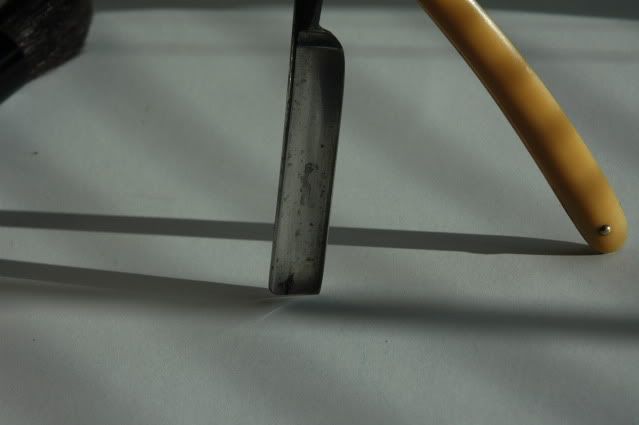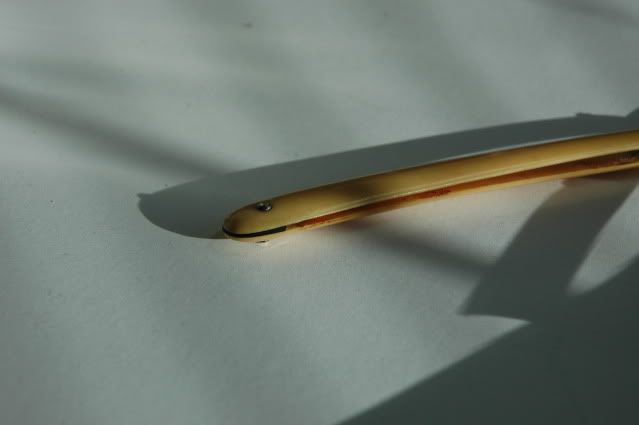Results 1 to 10 of 20
Thread: Celluloid Rot
-
02-19-2010, 04:57 AM #1
 Celluloid Rot
Celluloid Rot
OK, before I start this I am going to state that I did try to search this one before posting, but since one can not search for three letter words, it makes it much harder to find anything on this. I also looked in the WIKI, but didn't see anything relevant there either.
Anyway, my question is on celluloid scales, how do you know if they have rot or just need to be cleaned up? And can the rot be cleaned or removed and if so how?
-
02-19-2010, 05:14 AM #2

There was another post about this recently elsewhere. One way to check if it is celluloid rot was to put the item in question in a zip lock for a couple of days and then smell it(per glen) if it smells funky then probably is.As far as saving, it would probably depend on how bad it has gotten.
-
The Following User Says Thank You to Strikur For This Useful Post:
drej16 (02-21-2010)
-
02-19-2010, 05:18 AM #3

Best to post a photo of the blade and scales if possible. Is the blade covered with rust where it goes into the scales ? If it is it may be the rot. OTOH, sometimes it is grunge and that can be cleaned. Pound a couple of q-tips flat on the end to where they will fit in between the scales.
I like scrubbing bubbles pump spray and soak the scales with that. I rub the stuff out with the q-tips and a soft toothbrush. I use flat dental floss with metal polish around the pivot. I hear that if it is rot it won't go away but haven't personally ran into one that didn't clean up so maybe I've been lucky so far.Be careful how you treat people on your way up, you may meet them again on your way back down.
-
The Following User Says Thank You to JimmyHAD For This Useful Post:
drej16 (02-21-2010)
-
02-19-2010, 10:08 AM #4At this point in time...




- Join Date
- Jun 2007
- Location
- North Idaho Redoubt
- Posts
- 27,069
- Blog Entries
- 1
Thanked: 13249
There are other clues here guys...
What brand is the razor
What are the scales like...
Color
Pattern
Warps
Cracks
Actually fiber disintegration
Corrosion on the blade
Corrosion on the blade in a pattern
Corrosion on the blade that returns quickly
Smell
All these are signs of Celluloid rot and once it is present it cannot be cleaned and it will destroy that razor and any other Celluloid that the gasses can get to...
NOW you have to diagnose this like doctors do, any one symptom doesn't necessarily mean that it is rot, if you find one, look for another, and Celluloid scales are not all made from the same formula so they don't all do the same thing...
-
The Following 3 Users Say Thank You to gssixgun For This Useful Post:
drej16 (02-21-2010), onimaru55 (02-19-2010), ScottGoodman (02-24-2010)
-
02-19-2010, 10:36 AM #5

I've never smelt celluloid scale rot, but I do remember opening an old celly film canister that had started to rot. It smelt very vinegary, pungent and pretty unpleasant!
My DOVO Bismarck has celluloid scales, and it smells a little bit like camera film when I open the box it is stored in. Not strong or nasty, just a slight camera film aroma. I quite like the smell actually, it reminds me of looking through the drawers full of family pictures that my dad took when I was younger!
-
The Following User Says Thank You to Stubear For This Useful Post:
drej16 (02-21-2010)
-
02-19-2010, 10:53 AM #6
-
The Following User Says Thank You to onimaru55 For This Useful Post:
drej16 (02-21-2010)
-
02-19-2010, 01:28 PM #7Senior Member



- Join Date
- Apr 2008
- Location
- Essex, UK
- Posts
- 3,816
Thanked: 3164
The vinegar smell is associated with cellulose acetate. In the movie industry "vinegar syndrome" is the name given to it. The smell occurs when the free acetic acid is released, leading to crumbling and complete ruin of the film. Whole movie warehouses were once affected.
Cellulose acetate was made as a safer, tougher alternative to the original formulation of cellulose nitrate, which could become volatile and spontaneously combust, and which released nitric acid vapour. This type of celluloid is now very rarely encountered.
There is another smell - camphor - released by celluloid. Camphor was used as an agglutinising agent and also as a preservative.
The filler in celluloid scales inhibits the rot - dark scales (plenty of filler) hardly ever get it - light, amber, honey-coloured scales (little or no filler) get it more often. That begs the question whether the filler is screening out something (UV light perhaps) or whether the predominance of filler is always accompanied by smaller amount of celluloid, in reverse proportion to filler density.
The main problem is that celluloid and its derivatives were inherently unstable, containing free acid content that can be emitted as a gas. Some had a lot of free acid, some very little.
Some types of celluloid are not affected by cell rot at all, and not everything that looks like celluloid can be rigidly defined as celluloid!
I also believe that the "contageous" theory of cell rot is a myth. It's only my own opinion, backed by a bit of research, so if you have done your own reserach feel free to trounce it.
If the stuff is going to break down it will, hastened by environmental factors like heat/light/dark/humidity, etc, and becoming more apparent (not exacerbated) if kept in confined conditions (an analogy - the stars are still there, shining away, in the daylight - nightfall does not make them shine, it just makes it obvious that they do). If it isn't going to break down it won't be affected by scales that will. Some time ago I unpinned a lot of suspect celluloid scales and put them in an open box in my shed. After many months only the rotting ones were deteriorating - the rot had not spread to the other scales that were not rotting when put in the box. Someone - Glenn I think - observed that the box I kept them in was open-topped, so the gases could disperse and not do any damage. That was a long time ago and since then a close-fitting top has been kept on the box. The unaffected scales are still unaffected.
That is not to say that blades in unaffected razors will not be attacked by one set of rotting scales - they will. The acid vapour will attack neighbouring metal, but not neighbouring celluloid.
Others have given good ideas on how to spot the rot in the first place. The strong smell and the presence of corrosion and pitting on the razor blade are all you need. If you clean the blade and leave it in the same scales and it corrodes again, that is pretty definite proof. A slight aroma is not an indication of rot.
Regards,
Neil
-
-
02-21-2010, 06:26 PM #8

Thanks for all the awesome information and great replies. After reading through these, I am going to go with that these scales are rotting. I have been trying to get some pictures that show it, but it is still small at the moment and hard to see in an image. But the blade corrodes very fast where it is close to the scales, and the scales are discolored there as well as another place on the edge, and there is also some corrosion on the blade there as well. So, it looks like I will be rescaling these.



Thanks again for all your great feedback.
-
02-22-2010, 03:04 AM #9At this point in time...




- Join Date
- Jun 2007
- Location
- North Idaho Redoubt
- Posts
- 27,069
- Blog Entries
- 1
Thanked: 13249
This is very dangerous making a statement like this, when we have one of our very own SRP members that has lost parts of a major collection to this exact problem... (he can pipe up if he wants)
Now I don't mind wanting proof, and maybe there needs to be certain conditions present for the off gassing to occur, BUT you ain't convincing me one little bit that it is safe, Sorry... if there is even a small chance it can happen I am keeping any suspect razors seperate...
-
The Following User Says Thank You to gssixgun For This Useful Post:
drej16 (02-22-2010)
-
02-22-2010, 05:50 AM #10

IThe reason cell "rots" is not biological, obviously. It is because it is a self-catalysing reaction.... if the razors are stored in a sufficiently close proximity or closed space, it WILL spread.
Fact.
The process that creates Celluloid:
Cellulose-NO2 + HNO3 + H2O <--> Cellulose-OH+(2)HNO3
"As the arrows indicate, this reaction is reversible in the presence of nitric acid and water. The nitrate groups oxidize the cellulose residues and produce nitrous oxides that catalyze further reactions." (Reilly, Julie A. Celluloid Objects: Their Care and Preservation. Journal of the American Institute for Conservation. v.30 n. 2 1991 pp.145-162)
While some celluloid had different solvent and filler mixes, all are based on this formula. This is where the chemicals are synthized...everything else is just a mixture...
Moral of the story: All celluloid rots. It is 'contagious' by nature of its self-calaysis.Last edited by BKratchmer; 02-22-2010 at 06:14 AM. Reason: Used JSTOR to inject 30cc of FACTS
-
The Following User Says Thank You to BKratchmer For This Useful Post:
drej16 (02-22-2010)


 LinkBack URL
LinkBack URL About LinkBacks
About LinkBacks







